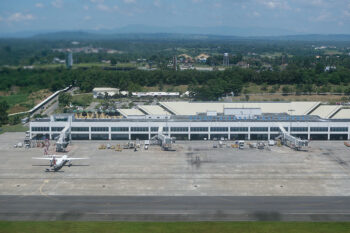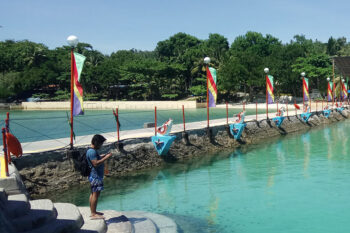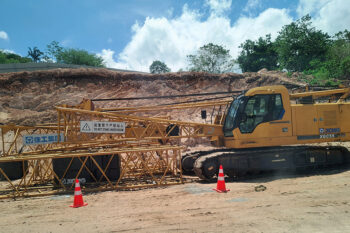Because of this direct line between producers and buyers, he added, some of the growers in the area have gotten somewhat envious: “So our commitment now is to training growers in other neighboring areas on what we have learned,” he said.
He was referring to the training and market linkage assistance that his group obtained with the help of USAID’s Growth with Equity in Mindanao (GEM) Program, which has focused on providing a wide range of technical assistance to enhance the banana supply chain, particularly for cardaba banana. The technical support provided by GEM included seminars on best farming practices and effective pest and disease management, and the facilitation of market linkages between cardaba growers and banana chip processors.
The enhanced supply chain gave the banana processors direct access to raw materials, although they have to compete with buyers in public markets and other viajeros. Lately, they have also had to deal with traders who have started sourcing fresh cardaba from Mindanao to augment the shortage in Luzon, where banana farms have been devastated by the series of super typhoons late last year.
Through the Mindanao Fruit Council (Minfruit Council), one of the business support organizations assisted by USAID’s GEM Program, 12 seminars have been conducted in key cardaba producing areas. The seminars have been attended by approximately 1,000 farmers in North Cotabato, Sarangani, Davao del Norte, Compostela Valley, Bukidnon, Lanao Norte, Misamis Occidental and by Mr. Yacapin’s group in Misamis Oriental, and have provided training on improving productivity and the quality of the products. Representatives of banana chip processors have been invited to some of the sessions, which has enabled the growers to speak directly with the buyers. The GEM training program, together with the Minfruit Council, has also provided technical assistance in organizational management to growers and their associations, like that of Mr. Yacapin.
Banana chips processors have also benefited from the supply chain improvement efforts. The GEM Program has provided processors with assistance in accessing new foreign markets, particularly in China. Total Philippine banana chip exports to China rose sharply from about US$ 120,000 in 2002 to more than US$ 5.2 million in 2006. Another emerging export market for local banana chips is the Russian Federation where total shipments have reached a million dollars in 2006, growing ten times during the past five years.
During the past two years, GEM has helped six Mindanao banana chip processors to join major trade fairs in China, which provided venues for the processors to access the China market, the Philippines’ fastest-growing buyer of banana chips. This year, GEM is helping to promote Philippine banana chips during the Food, Hotel and Catering Show in Beijing in June and will assist Mindanao processors to book advance orders from food suppliers and institutions preparing for the Beijing Olympics in 2008.
GEM’s assistance to the banana chip industry has also benefited former MNLF combatants who, after receiving training, have started growing this popular crop. GEM’s Targeted Commodity Expansion Program-Livelihood Enhancement and Peace Program, assisted them to diversify their traditional activities, through the establishment of cardaba farms.
About 600 farmers in North Cotabato, Lanao del Sur and Lanao del Norte began planting cardaba banana two years ago. Early last year, the farmers had their first harvest and made regular fruit deliveries to a processing plant in North Cotabato, giving them a year-round income.
These support efforts have been successful because banana chips have become an important product for the export market. The production of banana chips has emerged as one of Mindanao’s strategic industries. There are now more than twenty banana chip processing plants in Mindanao compared to 15 factories five years ago.
The annual value of banana chips exports from the Philippines is approximately $35 million, and 70-80% of the product comes from Mindanao, where cardaba bananas are grown throughout the region. Although annual exports declined in 2005 due to trade-related issues in the China market, the market rebounded in 2006, with export volumes to China recovering and growing by a robust 16% versus the previous year.
Thousands of small banana growers depend on the chip processors as primary markets for their produce, as the raw material needs of the banana chip industry require the yield of at least 30,000 hectares annually. Since cardaba production is dominated by small-holder growers, with average farm size of one hectare or less, the total number of farmers involved ranges from 30,000 to 50,000.
Industry data show that traditional markets like the United States, the European Union, Japan, Australia and South Korea have consistently expanded, although emerging markets, particularly China and Russia and former Eastern Bloc countries have posted exponential growth in the last four years. The most surprising market perhaps is Vietnam, where the imports of banana chips from the Philippines has surged over the past three years. Vietnam has become a trans-shipment point for Philippine banana chip exports to China because it enjoys preferential tariff rates with China due to long-standing bilateral agreements between the two countries.
In the Davao Region, the Trade Department launched the product as a substitute for junk foods in school canteens, in an effort to help spur local demand. The agency commissioned a private company to formulate new banana chips variants in an attempt to encourage students to try the product because of its nutritional value. A dozen new varieties were successfully launched last year. Homegrown singer Joey Ayala was hired to compose a catchy jingle to promote the product to school children.
Last year, Mindanao exported about $16.3 million of banana chips, or 45% of the banana chip exports of the country. The value was 40% higher than the value in the previous years.
With the farmers already having direct links with the processors and other markets, and with demand increasing steadily, banana growing has become an attractive proposition. (GEM Program)







